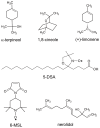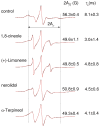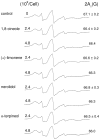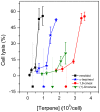Terpenes increase the lipid dynamics in the Leishmania plasma membrane at concentrations similar to their IC50 values
- PMID: 25101672
- PMCID: PMC4125203
- DOI: 10.1371/journal.pone.0104429
Terpenes increase the lipid dynamics in the Leishmania plasma membrane at concentrations similar to their IC50 values
Abstract
Although many terpenes have shown antitumor, antibacterial, antifungal, and antiparasitic activity, the mechanism of action is not well established. Electron paramagnetic resonance (EPR) spectroscopy of the spin-labeled 5-doxyl stearic acid revealed remarkable fluidity increases in the plasma membrane of terpene-treated Leishmania amazonensis promastigotes. For an antiproliferative activity assay using 5×10(6) parasites/mL, the sesquiterpene nerolidol and the monoterpenes (+)-limonene, α-terpineol and 1,8-cineole inhibited the growth of the parasites with IC50 values of 0.008, 0.549, 0.678 and 4.697 mM, respectively. The IC50 values of these terpenes increased as the parasite concentration used in the cytotoxicity assay increased, and this behavior was examined using a theoretical treatment of the experimental data. Cytotoxicity tests with the same parasite concentration as in the EPR experiments revealed a correlation between the IC50 values of the terpenes and the concentrations at which they altered the membrane fluidity. In addition, the terpenes induced small amounts of cell lysis (4-9%) at their respective IC50 values. For assays with high cell concentrations (2×10(9) parasites/mL), the incorporation of terpene into the cell membrane was very fast, and the IC50 values observed for 24 h and 5 min-incubation periods were not significantly different. Taken together, these results suggest that terpene cytotoxicity is associated with the attack on the plasma membrane of the parasite. The in vitro cytotoxicity of nerolidol was similar to that of miltefosine, and nerolidol has high hydrophobicity; thus, nerolidol might be used in drug delivery systems, such as lipid nanoparticles to treat leishmaniasis.
Conflict of interest statement
Figures







Similar articles
-
Effects of nerolidol and limonene on stratum corneum membranes: A probe EPR and fluorescence spectroscopy study.Int J Pharm. 2017 Oct 30;532(1):547-554. doi: 10.1016/j.ijpharm.2017.09.046. Epub 2017 Sep 19. Int J Pharm. 2017. PMID: 28935253
-
In vitro antileishmanial and cytotoxic activities of nerolidol are associated with changes in plasma membrane dynamics.Biochim Biophys Acta Biomembr. 2019 Jun 1;1861(6):1049-1056. doi: 10.1016/j.bbamem.2019.03.006. Epub 2019 Mar 16. Biochim Biophys Acta Biomembr. 2019. PMID: 30890467
-
Miltefosine increases lipid and protein dynamics in Leishmania amazonensis membranes at concentrations similar to those needed for cytotoxicity activity.Antimicrob Agents Chemother. 2014 Jun;58(6):3021-8. doi: 10.1128/AAC.01332-13. Epub 2014 Mar 10. Antimicrob Agents Chemother. 2014. PMID: 24614380 Free PMC article.
-
Toxicity of terpenes on fibroblast cells compared to their hemolytic potential and increase in erythrocyte membrane fluidity.Toxicol In Vitro. 2013 Feb;27(1):323-9. doi: 10.1016/j.tiv.2012.08.022. Epub 2012 Aug 27. Toxicol In Vitro. 2013. PMID: 22944593
-
Inhibitory activity of limonene against Leishmania parasites in vitro and in vivo.Biomed Pharmacother. 2009 Nov;63(9):643-9. doi: 10.1016/j.biopha.2009.02.004. Epub 2009 Mar 10. Biomed Pharmacother. 2009. PMID: 19321295
Cited by
-
In Vitro antileishmania activity of sesquiterpene-rich essential oils from Nectandra species.Pharm Biol. 2017 Dec;55(1):2285-2291. doi: 10.1080/13880209.2017.1407803. Pharm Biol. 2017. PMID: 29185382 Free PMC article.
-
Leishmanicidal Activity of Betulin Derivatives in Leishmania amazonensis; Effect on Plasma and Mitochondrial Membrane Potential, and Macrophage Nitric Oxide and Superoxide Production.Microorganisms. 2021 Feb 4;9(2):320. doi: 10.3390/microorganisms9020320. Microorganisms. 2021. PMID: 33557150 Free PMC article.
-
Therapeutic switching: from antidermatophytic essential oils to new leishmanicidal products.Mem Inst Oswaldo Cruz. 2015 Feb;110(1):106-13. doi: 10.1590/0074-02760140332. Epub 2015 Feb 13. Mem Inst Oswaldo Cruz. 2015. PMID: 25742270 Free PMC article.
-
Antiviral, Antibacterial, Antifungal, and Antiparasitic Properties of Propolis: A Review.Foods. 2021 Jun 11;10(6):1360. doi: 10.3390/foods10061360. Foods. 2021. PMID: 34208334 Free PMC article. Review.
-
Bicelles as a carrier for bioactive compounds in beverages: application to nerolidol, an active sesquiterpene alcohol.J Food Sci Technol. 2022 Mar;59(3):1030-1039. doi: 10.1007/s13197-021-05107-3. Epub 2021 May 5. J Food Sci Technol. 2022. PMID: 35185207 Free PMC article.
References
-
- WHO (2014) Leishmaniasis. Fact sheet N°375. January 2014. Available: http://www.who.int/mediacentre/factsheets/fs375/en/. Accessed 2014 Jun 12.
-
- Oliveira LF, Schubach AO, Martins MM, Passos SL, Oliveira RV, et al. (2011) Systematic review of the adverse effects of cutaneous leishmaniasis treatment in the New World. Acta Trop 118: 87–96. - PubMed
-
- Sharma M, Chauhan K, Shivahare R, Vishwakarma P, Suthar MK, et al. (2013) Discovery of a new class of natural product-inspired quinazolinone hybrid as potent antileishmanial agents. J Med Chem 56: 4374–4392. - PubMed
-
- Chappuis F, Sundar S, Hailu A, Ghalib H, Rijal S, et al. (2007) Visceral leishmaniasis: what are the needs for diagnosis, treatment and control? Nat Rev Micro 5: S7–S16. - PubMed
-
- Guerin PJ, Olliaro P, Sundar S, Boelaert M, Croft SL, et al. (2002) Visceral leishmaniasis: current status of control, diagnosis, and treatment, and a proposed research and development agenda. Lancet Infect Dis 2: 494–501. - PubMed
Publication types
MeSH terms
Substances
LinkOut - more resources
Full Text Sources
Other Literature Sources

